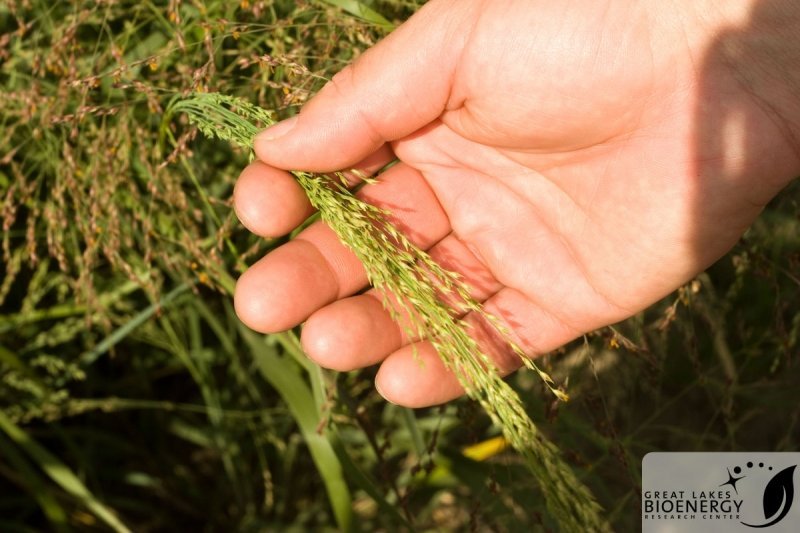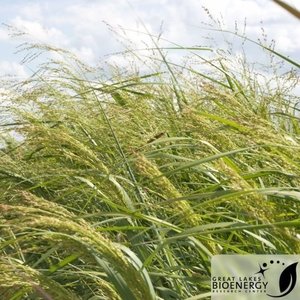Researchers study best time to harvest switchgrass



Great Lake Bioenergy Research Center
September 25, 2018
BY Paige Short, Michigan Tech
Switchgrass is a promising biofuel alternative to corn, but farmers, environmentalists and biofuel developers, find deciding on the right time to harvest particularly thorny.
Generating biofuels from agricultural sources is nothing new; the United States has been using corn to generate ethanol for decades. Until now, corn has been a passable biofuel source, but it is an annual crop requiring yearly planting, costly fertilization and irrigation, as well as a narrow harvest window dependent on grain maturity. The benefits of using dedicated energy crops, crops grown with the sole purpose of being used to create fuels, give plants like switchgrass a hefty leg up over corn.
Switchgrass, unlike corn, is a low-resource perennial plant. This not only saves on replanting costs—switchgrass stands are expected to last for 20 years—but also allows its root system to stay in the ground, reducing risk of erosion and run-off while channeling fertilizing nitrogen back into the soil. Switchgrass serves as a wildlife habitat for birds and predatory insects and is exceptional at sequestering carbon into the soil, meaning it can pull carbon dioxide from the air to help combat greenhouse gas emissions. And since switchgrass harvest isn’t dependent on grain maturity, farmers have more options when it comes to timing.
Energy Crop Harvesting: When is Best?
The current viable harvest window for switchgrass extends from peak biomass, when the grass is at its biggest before it begins to degrade from weathering, to the first killing frost, when the plant shuts down completely for the winter. The longer the plant stays in the field, the more nitrogen returns to the soil—a clear environmental benefit—but this extra time reduces the amount of biomass harvested from the crop. Future biofuel manufacturers may want to harvest multiple times per season to efficiently use storage facilities, while farmers must consider weather and the harvest times of their other crops. A conundrum.
Nailing down a definitive answer to the switchgrass harvest debate is something Rebecca Ong, assistant professor of chemical engineering, is exploring in her research. Working with researchers from the University of Tennessee, the University of Wisconsin-Madison and Michigan State University, Ong monitored and sampled several stands of Wisconsin switchgrass to better understand the costs and benefits to harvesting at various points in the season. The work is part of the Great Lakes Bioenergy Research Center.
Advertisement
Microbes Shake Up the Data
Once harvested, switchgrass doesn’t magically become biofuel; the crop has to be broken down and fermented to convert its natural sugars into ethanol. Harvest times affect conversion efficiency and research until Ong's has demonstrated that, generally, earlier is better.
Comparing data from samples collected every two to three weeks from the switchgrass fields against biofuel yield data from each site, Ong discovered something rather unusual: As the crop aged past senescence, the point at which plants begin to go dormant for the winter, ethanol yields from the harvested crop became more efficient rather than less so.
Ethanol is produced from energy crops like switchgrass in a two-step process: First, using chemical and biological processes to break down the plants’ cell walls, accessing and splitting the complex polymeric sugar chains into individual sugars; then applying biological processes (usually microbe-aided fermentation) to convert the sugars into ethanol.
The types of sugars present in each energy crop vary, and the microbes often need some persuading to utilize certain sugars like xylose, one of those found in switchgrass. Previous researchers at Purdue University have engineered yeast, the microbe involved in switchgrass fermentation, to break down xylose, but the process can be fickle and sensitive to inhibition.
“Something we’re trying to do [in our lab],” Ong says, “is break up that polymer, break all the links so that we have those individual sugars and then convince the microbes that they want to actually eat them.”
Advertisement
In the later samples from Ong’s study, the yeast didn’t need convincing. The xylose had become consumable.
Ong believes this change is due to plant senescing, which is when plants begin to go dormant and dismantle compounds in their stems and leaves for storage and reuse the following growing season. When the switchgrass was harvested before senescence, one or more of these compounds might have been interfering with the microbes’ ability to digest the xylose. Giving the plants more time in the field may have made the switchgrass sugar more appealing to the yeast. “Most of the time,” Ong says, “people say ‘harvest early, get the highest conversions,’ but no one has taken it through fermentation to see what the microbes do in the process.”
Sooner or Later, It All Goes to Seed
And while this might be good news for the environment and the biofuel manufacturing process, this much later harvest window puts a strain on farmers who are limited by weather, regardless of fascinating sugar behaviors.
The next step, according to Ong, is to figure out what compound or compounds are inhibiting the xylose conversion earlier in the harvest season. Once identified, they can deploy strategies to mitigate the effects, like engineering the biofuel-making microbes to be more tolerant, giving farmers more room to harvest switchgrass during good weather.
Related Stories
Moeve has reached a strategic agreement with Grupo Armas Trasmediterránea to supply 2G marine biofuels in the Canary Islands, with approximately 40,000 tons to be delivered through December 2025 under a long-term contract.
Castle & Cooke Aviation, a premier provider of luxury FBO services, now offers sustainable aviation fuel (SAF) from Avfuel Corp. at Van Nuys Airport (VNY) in Southern California. The SAF produced by Neste.
A notice published in the Federal Register by the U.S. EPA indicates that far fewer parties than originally anticipated have registered with the agency as biointermediate producers under the Renewable Fuel Standard.
General Index and ATOBA Energy are partnering to bring a brand-new vision of how SAF benchmarks are built. SAF indexes need to be tailored to the unique cost profiles of diverse production technologies, the companies said.
The Singapore Airlines Group has signed agreements with Neste and World Energy to acquire sustainable aviation fuel (SAF) and SAF certificates, respectively. The purchases include 1,000 metric tons of neat SAF from Neste.
Upcoming Events










